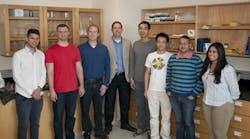Researchers at Washington State University, Pullman, Wash., have developed a bio-based method to create a variety of polyurethanes that promises economic and environmental benefits. The scientists, working with colleagues from Iowa State University, Ames, Iowa, and Cairo University, Orman-Giza, Egypt, have operated the solvent- and catalyst-free process using olive, canola, grape seed, linseed and castor oils.
Figure 1. Professor Kessler (fourth from left) and his research team at Washington State University are working on bio-based plastics. Source: Michelle White, Washington State University.
“What’s new about this is specifically the way we make the polyols,” says Michael Kessler, a professor at the university’s School of Mechanical and Materials Engineering who led the research. “The novelty of this particular work is that these polyurethanes are using a new chemistry made by a combination of castor oil fatty acid and modified vegetable oils,” he adds.
The work started in 2012 with polyols from soybean oil and later expanded to other vegetable oils. “We worked on it for a little under two years,” notes Kessler. The team first oxidized bio-based triglyceride oils into epoxidized vegetable oils with formic acid and hydrogen peroxide. Instead of following this with the typical petroleum-based ring-opening reactants, the researchers turned to castor oil fatty acid to create the polyols.
The molecular structures of the polyols and the resulting polyurethane varied depending on the vegetable oils used. Some oils, like linseed oil, have five or six reactive sites, making the material stiffer. Others, such as olive oil, have fewer reactive sites, giving a more flexible material. More details on the process appear in an article in the journal ACS Applied Materials & Interfaces.
“The shape memory properties of these polyurethanes are quite interesting. One challenge that remains to be addressed is finding ways to exploit this novel behavior for useful applications,” says Kessler.
“Future direction could include evaluating bio-based diisocyanates (to go along with the bio-based polyols described in our paper). I would also like to apply these polyurethanes into some of the water-borne polyurethane dispersion research that we’ve been working on,” he adds.
The polyol yields are very similar to those of vegetable oil polyols made via conventional methods. However, the new method boasts cost, scale-up and environmental benefits, he contends.
The process offers savings in the production cost of making polyols because it obviates solvent and catalyst, and its simplicity and lack of petroleum-based ring-opening agents provide significantly lower environmental impact, he explains.
Currently, the researchers have no plans to scale-up the work. However, Kessler anticipates many related technologies based on this work will grow out of the university’s Center for Bioplastics and Biocomposites (www.cb2.iastate.edu).
The center, started last fall, is a collaboration between WSU and Iowa State University; Kessler is site director. It reportedly is the first industry and university cooperative research center devoted to developing bio-based plastics. The center has about 25 member companies and is co-funded by the National Science Foundation. “Through the center, we hope to involve the member companies in transitioning [this] technology into the marketplace.”
Member companies get royalty free, non-exclusive rights to any technology developed through the center, he adds.

